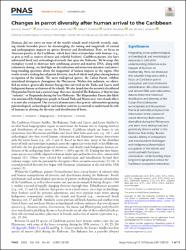/admin/item?itemID=9dd16e29-7a5e-408f-b7f6-02cd534759aa
Changes in parrot diversity after human arrival to the Caribbean

View/
Type of Access
OpenMaterial Type
ArticleType of Content
Scientific researchLanguage
EnglishCollection
- Investigación ambiental [1743]
Metadata
Show full item record| Abstract: | Integrating across paleontological, archaeological, and neontological resources is critical for understanding millennial-scale impacts of humans on biodiversity. Here, we showcase this valuable integration, with a focus on Caribbean parrot extirpation and cross-Holocene redistribution. We utilize modern and ancient DNA and radiocarbon data to determine historical distribution and diversity of the Cuban Parrot (Amazona leucocephala) and Hispaniolan Parrot (A. ventralis) and place this information in the context of extant diversity. Both species diversified during the Pleistocene and were more widespread and genetically diverse earlier in the Holocene than today. Results reveal a history of extirpations and translocations that began with Indigenous (Amerindian) occupation of the islands and continued with European colonization. Understanding these long-term dynamics is critical for Caribbean ecosystem restoration. |
| Author(s): | Oswald, Jessica A.
Tilston Smith, Brian Allen, Julie M. Guralnick, Robert P. Steadman, David W. LeFebvre, Michelle J. |
| Date: | 2023 |
| Published: | Proceedings of the National Academy of Sciences, 120(41), e2301128120 |
| Citation: | Oswald, J. A., Smith, B. T., Allen, J. M., Guralnick, R. P., Steadman, D. W., & LeFebvre, M. J. (2023). Changes in parrot diversity after human arrival to the Caribbean. Proceedings of the National Academy of Sciences, 120(41), e2301128120. Recuperado de: |
| URI: | https://bvearmb.do/handle/123456789/5075
|

